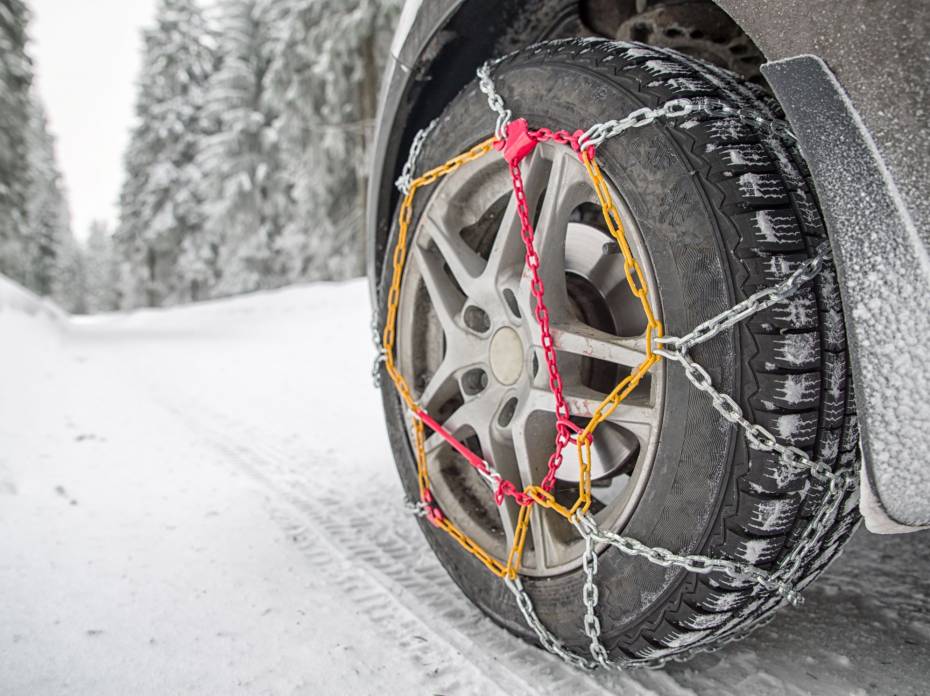Preview
Title
Laclede Chain 7021-038-11 Passenger Snap-Lock Cable Chains
Laclede Chain 7021-545-07 Alpine Premier Passenger Car Tire Chains
Laclede Chain 7021-030-11 Passenger Snap-Lock Cable Chains
Laclede Chain 7021-525-07 Alpine Premier Passenger Car Tire Chains
Laclede Chain 7021-550-07 Alpine Premier Passenger Car Tire Chains
Brand
Laclede
Laclede
Laclede
Laclede
Laclede
Price
$19.49
$25.00
$50.00
$20.85
$72.08
Checkout
View at Amazon
View at Amazon
View at Amazon
View at Amazon
View at Amazon
Preview
Title
Laclede Chain 7021-038-11 Passenger Snap-Lock Cable Chains
Brand
Laclede
Price
$19.49
Checkout
View at Amazon
Preview
Title
Laclede Chain 7021-545-07 Alpine Premier Passenger Car Tire Chains
Brand
Laclede
Price
$25. 00
Checkout
View at Amazon
Preview
Title
Laclede Chain 7021-030-11 Passenger Snap-Lock Cable Chains
Brand
Laclede
Price
$50.00
Checkout
View at Amazon
Preview
Title
Laclede Chain 7021-525-07 Alpine Premier Passenger Car Tire Chains
Brand
Laclede
Price
$20.85
Checkout
View at Amazon
Preview
Title
Laclede Chain 7021-550-07 Alpine Premier Passenger Car Tire Chains
Brand
Laclede
Price
$72.08
Checkout
View at Amazon
Today snow chains usually can be used in extreme winter road conditions. In addition, they are also used in muddy or sandy terrain to help the tires gain more traction because snow and ice were not the primary reason for the patent application, which was made in the summer month of August and in which snow and ice were not mentioned at all.
Weed with the chains after a possibility to move vehicles safely on muddy, muddy surfaces and unpaved paths and to prevent a stuck.
The basic problem with slippery surfaces is that the tires go crazy because they do not find any required adhesion on the ground. This can cause the vehicle to spin, slide sideways or simply come to a halt, as the vehicle cannot move from the spot due to the rotating tires, it could be because of snow chain is not fit to your tire size. Snow chains remedy this situation and ensure that there is sufficient traction to move the vehicle reliably and safely, even on very slippery and smooth surfaces, such as those that are present after heavy snowfall or when the road surface is icy.
But what is it all about this traction? Traction force is the ability of a vehicle to convert the driving force of the engine into propulsion. Of course, this is done via the wheels of the drive axle and how high the traction depends on various aspects. One of these is the nature of the subsoil. On a dry and solid road, traction is usually not an issue worth mentioning. However, on slippery surfaces such as ice or loose snow or even on muddy or sandy surfaces, there is a lack of traction and the driving force cannot be converted into an advance or only insufficiently. If there is already a forward movement of the vehicle, the lack of traction can also cause the vehicle to slip away, break out or spin and thus increase the risk of an accident. Through the use of cable snow chains, traction is increased and the vehicle can be moved well and safely even on slippery surfaces.
If there is already a forward movement of the vehicle, the lack of traction can also cause the vehicle to slip away, break out or spin and thus increase the risk of an accident. Through the use of cable snow chains, traction is increased and the vehicle can be moved well and safely even on slippery surfaces.
Snow chains do work in particular on inclines and slopes, there is often nothing left without snow chains on ice and snow, the wheels spin, the vehicle does not come out of the place or the already moving vehicle slips or begins to spin. Snow chains prevent this because they help the tires to a better grip, which ensures enough traction even on slippery roads.
The snow chains are usually mounted on the drive axle of the vehicle. They have to fit the respective vehicle and of course also to the tire size, so first you should do is to buy proper chain sizes, they are also called tire cables. The raised snow chains form a net on the tread of the tire, which often runs criss-cross over the tread.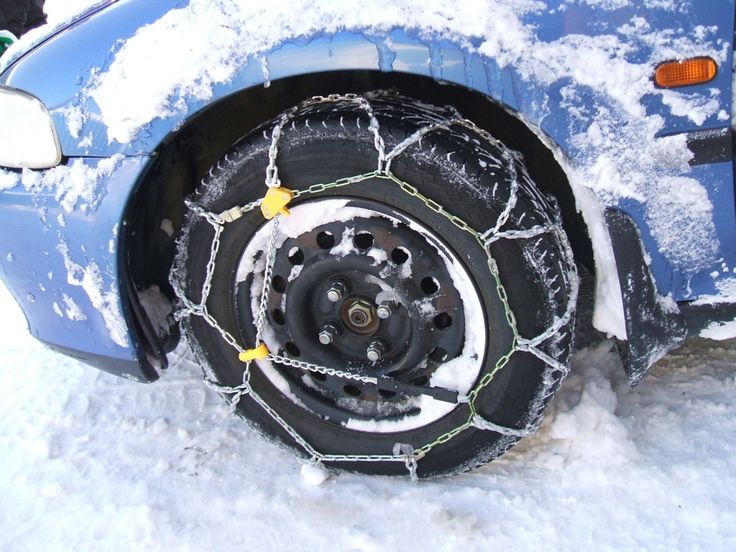 The chain pieces prevent the tires from spinning, giving the vehicle more grip and grip on slippery surfaces. Most of the snow chains are made of durable steel, but there are also snow chains made of plastic or textile on the market. The chain links are usually very angular and on some models are provided with additional grab bars with ice edges, which ensure particularly high adhesion. Some chains or cable tire chains are also equipped with loose, round chain link, whose task is to rid the chain of snow clumps and clumps. Similar to shoes with spikes, for example, the snow chains unfold their effect by helping the vehicle to better grip and avoid slipping away.
The chain pieces prevent the tires from spinning, giving the vehicle more grip and grip on slippery surfaces. Most of the snow chains are made of durable steel, but there are also snow chains made of plastic or textile on the market. The chain links are usually very angular and on some models are provided with additional grab bars with ice edges, which ensure particularly high adhesion. Some chains or cable tire chains are also equipped with loose, round chain link, whose task is to rid the chain of snow clumps and clumps. Similar to shoes with spikes, for example, the snow chains unfold their effect by helping the vehicle to better grip and avoid slipping away.
Due to the weight of the vehicle, the snow chains act twice on the tires. The tire link drills deep into the snow through the weight of the vehicle and bends there to provide a corresponding grip and at the same time, the tire is pressed into the chain structure. These two effects effectively prevent the tires from spinning.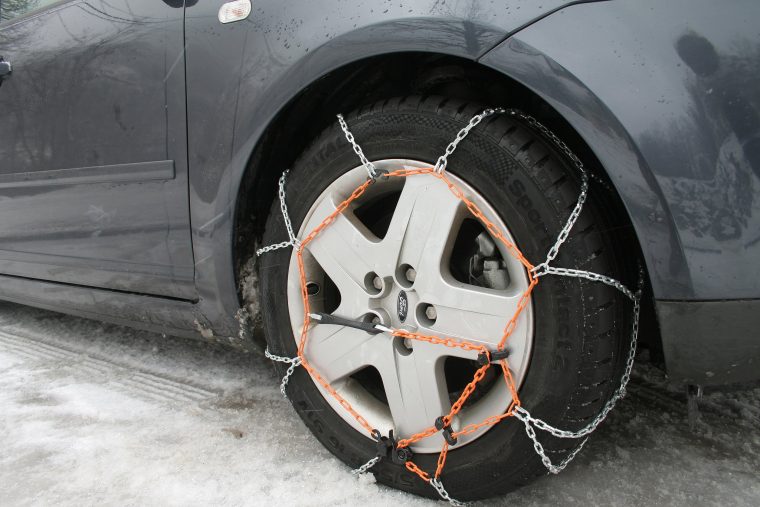
There are a lot of kinds of snow chains, if you want to buy snow chains, you will find quickly that on the market many different types of snow chains. One of the best tire cables or snow chains is the Laclede chain, it is a very high-quality product and popular manufacturer which develops a lot of different chain sizes.
In principle, a distinction must first be made between:
– Traction AIDS
– Full-fledged snow chains
In the case of full-fledged snow chains, a distinction is also made in:
-Drive chains
-Track chains
Unlike the full-fledged snow chains, starting aids do not cover the entire tire. They are rather plastic spikes or small chain nets, which are attached to the rim. They cover only a part of the tire and are suitable for overcoming short sections, gradients or gradients for which the use of full-fledged snow chains is not necessary, or to free the already stuck vehicle from its predicament.
The starting aid is attached to the tires of the drive axle.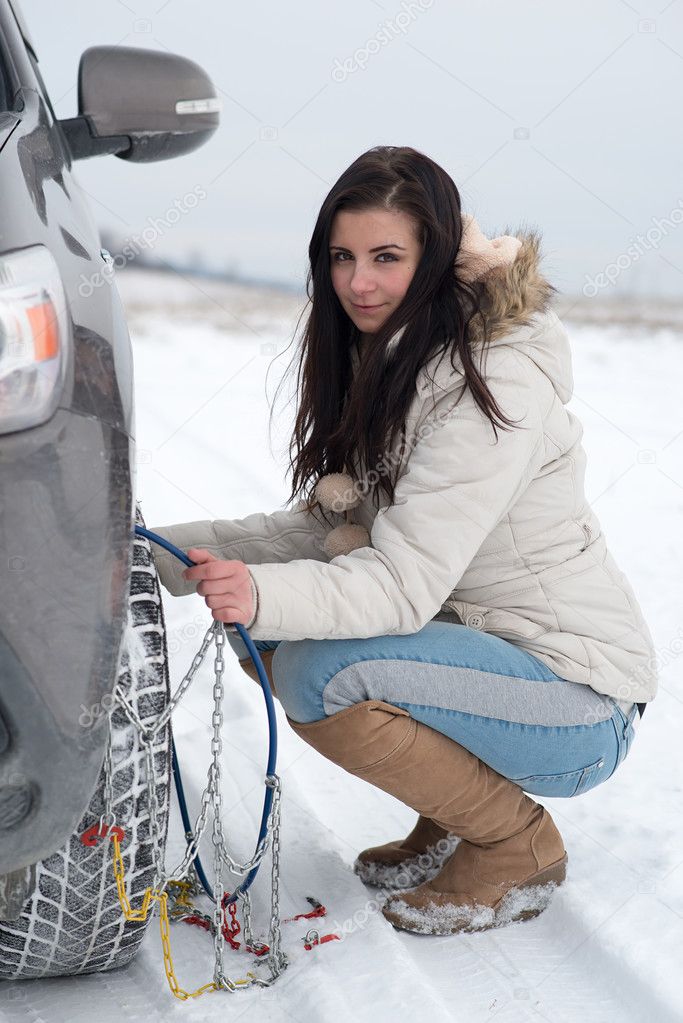 Depending on the Situation, several starting aids can also be installed per drive wheel. If the stationary vehicle is free or the short distance required to use the starting AIDS is overcome, the starting aids are removed again. The starting aids can be used on snow and ice as well as on muddy or muddy surfaces.
Depending on the Situation, several starting aids can also be installed per drive wheel. If the stationary vehicle is free or the short distance required to use the starting AIDS is overcome, the starting aids are removed again. The starting aids can be used on snow and ice as well as on muddy or muddy surfaces.
Starting aids are a practical aid in every season and are not limited to use in wintry road conditions. Most drivers will have experienced the situation before, that they have become stuck in sand or mud and a starting aid in the trunk solves these situations in no time. The starting aids are available for passenger cars as well as for off-road vehicles, SUVs, vans or campers and also for trucks and commercial vehicles.
Full-fledged snow chains cover not only a part but the entire tire. Depending on the type of cable snow chains, they are mounted on the tires of the drive axle or steering axle.
The drive chains, which are mounted on the tires of the drive axle, especially prevent the tires from slipping and spinning.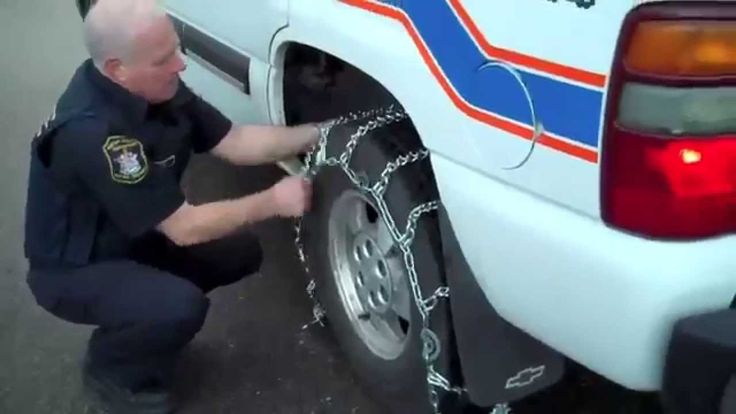 For this purpose, the chains run across the running surface. On the other hand, the track chains that are attached to the tires of the steering axle prevent the wheels from sliding sideways. For this purpose, the chain pieces run longitudinally directed to the running direction.
For this purpose, the chains run across the running surface. On the other hand, the track chains that are attached to the tires of the steering axle prevent the wheels from sliding sideways. For this purpose, the chain pieces run longitudinally directed to the running direction.
Although track chains prevent the vehicle from breaking out sideways and slipping away, there is still a risk that the drive wheels will spin in the case of track chains. All you need is to install the Laclede chain on your tires.
Modern snow chains or cable tire chains are usually a combination of track chains and drive chains, which are attached to the drive axis. The chain segments of these combined snow chains are usually arranged criss-cross and the cross-running chain segments are repeatedly connected by longitudinal pieces.
There are also differences in the material. Snow chains are very often made of resistant metal such as hardened steel. However, they are also available in plastic or textile or in different material combinations.
With these road conditions, you need snow chains, winter Laclede chain is one of the best on the market.
The best snow chains are needed especially in heavy snowfall and icy roads. If gradients and inclines come into play, the vehicle often does not move forward without snow chains. When skiing or winter holidays in the mountains where heavy snowfall is to be expected, cable snow chains definitely belong in the trunk. Especially during winter holidays, the snow chains must not be dispensed with.
If you want to be safe and be prepared for any eventuality, it doesn’t hurt to put a few snow chains in the trunk, even if you don’t go on holiday in winter sports areas and live in the lowlands, where it rarely snows. In exceptional cases, even in regions where heavy snowfall in Winter is not the rule, there may be an extreme onset of winter and then you are well equipped for all eventualities with a pair of snow chains in the trunk. Choose only the best snow chain, choose the best Laclede cable chain and your driving will always be under control, all you need is to know your tire size than you can easily find the right chain sizes or tire cables.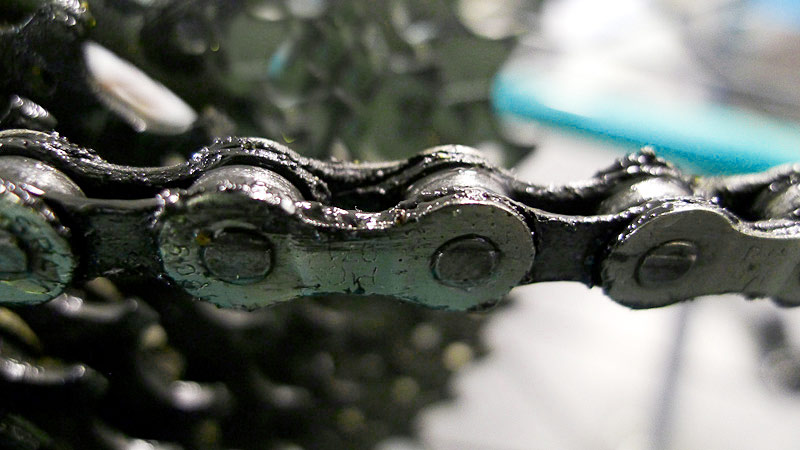
Share Article:
Aquiline Tire Chain Installation InstructionsAquiline Tire Chains provide traction solutions in the most demanding conditions for truck, tractor, grader and loader applications. They also have a special procedure for installation. Please click here to download Aquilines step by step instructions or call us at 1-866-437-5883 and one of our in-house tire chain experts will be glad to talk you through it! Installing chains for severe weather conditions.Installing today's snow chains is a fairly simple procedure, but it's a good idea to practice a little. If you have never driven on tire chains before and you can find softer ground, such as a dirt road, a test drive with chains installed can prepare you for the differences chains make on your car. Chains on the back wheels will limit your steering somewhat, while chains on the front wheels can cause your car's rear-end to react irregularly. Snow Chain Guidelines
Which chain size do you need for your vehicle?The easiest way to determine which size chains you need is to look at your tires. Whether you’re looking for chains for a car, truck, tractor, ATV, or whatever, every tire should be stamped with its size on the sidewall. To purchase the correct size, chains should have matching specifications to the tire. For the size 255/70R15 the numbers refer to;
The wrong size chains can and will damage the sidewalls of your tires.This could cause a blow out of the tire and be instrumental in an accident. Many low-profile cars do not have the clearance for chains between the fender and the tire itself.Before purchasing any chains, be sure your car and tires can accommodate them. Also, check with your local officials to make sure that chains are allowed in your area, some municipalities require the use of snow tires instead of chains. Please refer to our article regarding state tire chain laws. Tire Chain FAQ'sWhat are tire chains?Sounds like an obvious question but it's one we get asked. Tire chains are lengths of either cable or chain links that fit around a vehicle's tire to give it extra traction when driving through snow and ice. Sometimes tensioners are used to keep the chains firmly on the tires, these usually take the form of star-shaped rubber bungy style, or some chains come with tightening cams on the chains themselves that pull the chain tight once on the tire. Can you give me advice on how to put on tire chains?Our install page here: Installing Tire Chains gives advice and tips on how to install your chains, and most of our chain pages have an instructional how-to video at the bottom of the page as well, but if you can't see what you need then visit our youtube channel page for more instructional videos. What size tire chains do I need?Our helpful guide on our install page here: How to size chains gives you instructions on how to find the right chain to fit your tire. If you are looking for a chain to fit your ATV then contact us at (866) 437-5883. Because of the wide range of styles and sizes of ATV tires, it is best you talk to one of our experts to ensure you are getting the right chain that will fit your tire and not fall between the lugs or sit too loose on the tire. What advice can you give for driving in snow?See our page here: Driving in the snow for information about how to drive safer in snow and ice. Where to buy snow chainsWe ship internationally to most places, and shipping in the US is free, but if you are in the vicinity of Cedar Rapids, Iowa you can come by and purchase from our warehouse based at Cedar Rapids Tire. How much are snow chains?That pretty much depends on the vehicle you are driving and the style of chain you are looking for. Cable-based chains are usually cheaper than the heavier, and as a result stronger, linked chains. Chains designed for use on cars are also far cheaper than the large bulky chains used for tractors, graders, and other similar-sized vehicles. |
Category: Interesting news.
The truck tire industry is developing rapidly.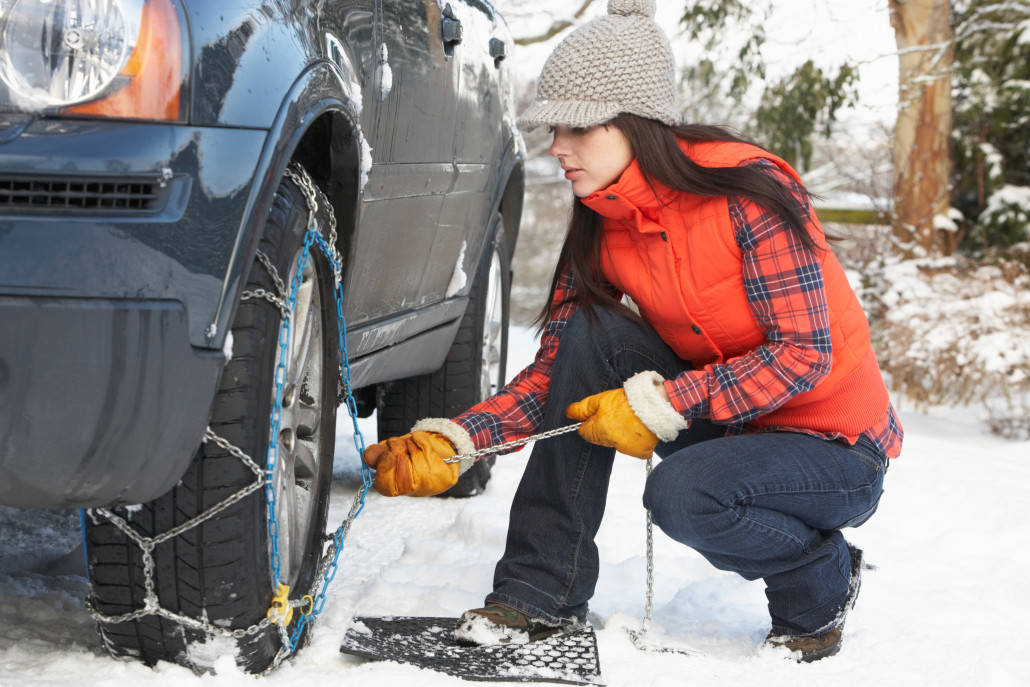 Designers improve the rubber compound, improve the tread pattern - and still, in winter it is impossible to do without such an old-fashioned accessory as snow chains . Consider why the driver needs chains and how to install them correctly.
Designers improve the rubber compound, improve the tread pattern - and still, in winter it is impossible to do without such an old-fashioned accessory as snow chains . Consider why the driver needs chains and how to install them correctly.
Snow chains are used off-road, in ice and to improve the grip of wheels with the road.
Due to the fact that the pattern of the chain protrudes outward and the contact area of the chains with the road is smaller than that of the wheel, there are gaps between the chain and the tire, the vehicle's flotation is improved, and wheel slip is prevented.
The main purpose for which truck drivers put chains on their wheels - is to ensure a confident ride on slippery roads and in snowdrifts, to increase the stability and controllability of the car due to better grip.

Experienced drivers always carry chains on their wheels. They rescue not only on the ice, but also help out at the cargo terminal if the snow is falling faster than it is removed by public utilities.
The variety of types allows you to find an option for any task - for certain types of trucks, for example, MAN and Scania, chains can be of different “caliber”, and their pattern is made in the form of “honeycombs”, “ladders”, etc. - depending on the type of road surface.
For heavy trucks and trucks, studded chains are mainly used to ensure tire grip in the most difficult areas.
In Europe and Scandinavia, road sections where chains must be used are marked with special signs.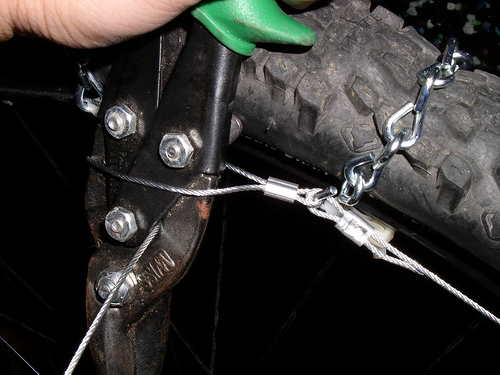 Not far from dangerous areas - sites for installing chains.
Not far from dangerous areas - sites for installing chains.
The requirements for installing chains in different countries are different: somewhere it is enough to “arm” only the drive axle, somewhere you need to put chains on all the wheels of the tractor and even on the wheels of the semi-trailer. Before you travel in winter, check the chain requirements for your itinerary.
Before leaving for flight , it is important to check the condition of chains and store them in special cases or strong plastic bags. Worn out chains break in transit and can shatter headlights and fender liner, damage the fuel tank and cargo, get stuck between the wheels and cause an accident.
The chains must fit the wheel size of your truck. The specifics of its installation, the type of fastening and the degree of tension depend on the type of chain.
Do not accelerate and brake sharply when driving with chains on wheels, exceed the recommended speed: 50 km/h for metal chains and 80 km/h for soft chains (rubber, plastic).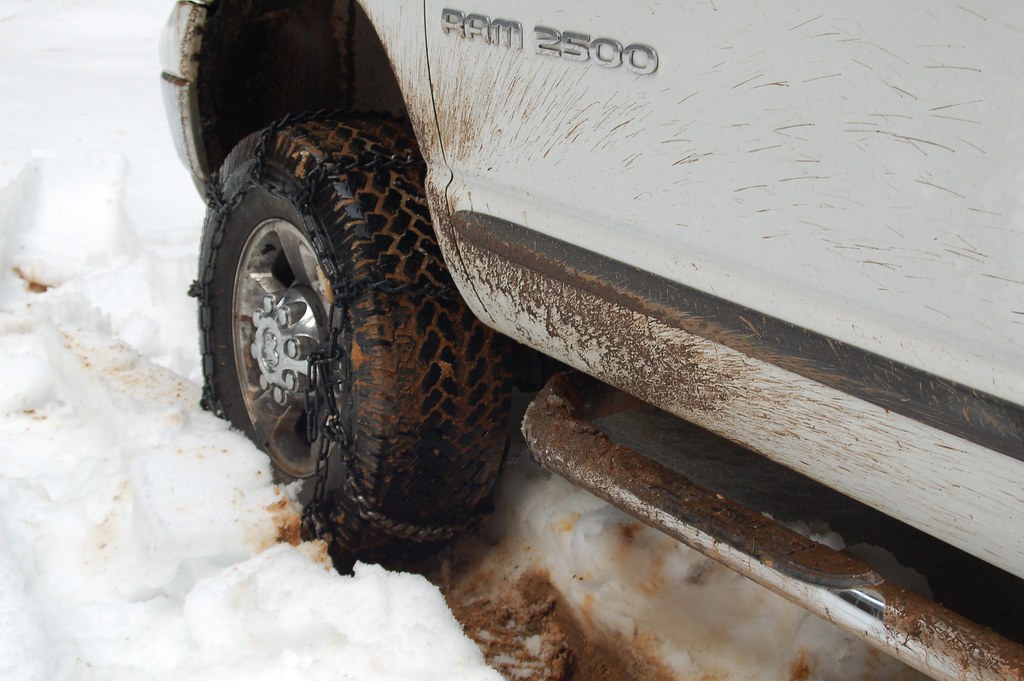 As the speed increases, centrifugal force can cause the chains to loosen, causing the chain to vibrate and contact the fender liner.
As the speed increases, centrifugal force can cause the chains to loosen, causing the chain to vibrate and contact the fender liner.
Immediately after the pavement has been replaced with clean asphalt, the chains must be removed - otherwise they will wear out quickly. After removal, the chain must be cleaned and dried.

Quality used spare parts for Scania trucks can be found in our catalog
LOOK FOR USED PARTS
 Ladder type and Honeycomb type
Ladder type and Honeycomb type Snow chains are a valuable addition to your forklift. Snow chains are a device to be used in an emergency situation and, therefore, when using them, it is necessary to observe the precautions and the attached rules of use in order to obtain the expected results, as well as to avoid possible problems arising from incorrect use of the chains.
Anti-skid chains are designed to prevent wheel slippage and increase the passability of the loader when driving on difficult road sections - ice, rolled snow, virgin snow.
Before using snow chains, it is necessary to determine the possibility of their installation on the vehicle. Recommended minimum clearances between the wheel and various parts of the loader required for installation:

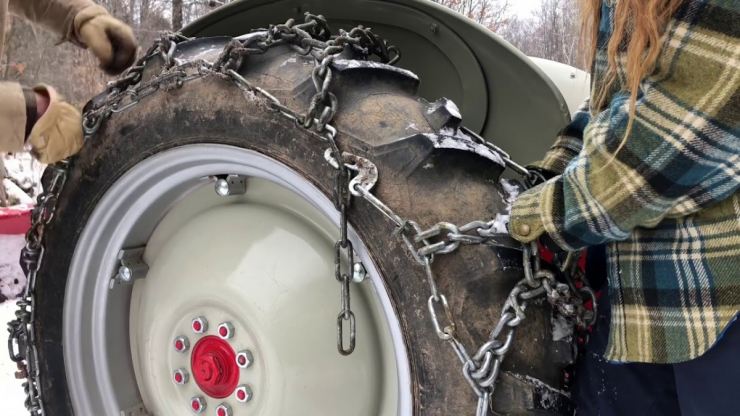
Anti-skid chains are mounted on the drive wheels of the loader.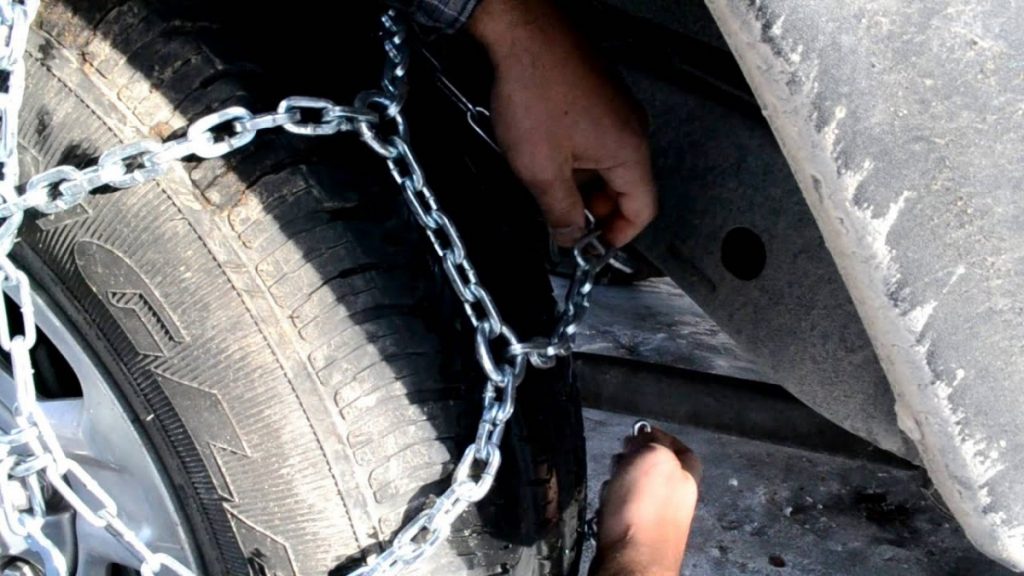 Installation of anti-skid chains must be carried out before entering a difficult road section.
Installation of anti-skid chains must be carried out before entering a difficult road section.
For different manufacturers of wheels for loaders with the same wheel marking, the actual dimensions can vary significantly.
To take into account the difference in wheel sizes, an additional jumper (pos. 7) is provided in the anti-skid chains. It is attached with staples to the end links of the tail chain (pos.6).
The need for an additional jumper is determined during the first installation. If the anti-skid chain hangs freely on the wheel during tension, warps on its side and further tension does not give the chain a snug fit to the wheel, then the additional jumper should be disconnected.
1. Carefully straighten the snow chain (chain links must not be twisted). Lay snow chains on the road surface and run the drive wheels over them. The locking hook (pos.2) with the locking ring (pos.3) must be located on the outside of the loader. Secure the loader in a position that prevents spontaneous movement on the road.
The locking hook (pos.2) with the locking ring (pos.3) must be located on the outside of the loader. Secure the loader in a position that prevents spontaneous movement on the road.
2. Throw the free part of the chain on the wheel. Spread the transverse branches of the chain (pos.4) evenly around the circumference of the wheel.
3. On the inner side of the wheel, hook the locking hook (pos.1) to one of the links of the tail branch (pos.6). Hook hook only on odd tail chain links 1, 3, 5, etc. (for loaders with a small distance between the wheel and other parts).
4. From the outer side of the wheel, thread the locking hook (pos.2) into one of the end links of the tail branch (pos.6) and turn the locking hook towards the locking ring (pos.3).
5. Insert the locking ring into the groove of the locking hook. If necessary, make an additional tension of the chain (reattach the locking hook and the hook for the following tail links). Longitudinal and transverse branches should grip the tire tightly.
Longitudinal and transverse branches should grip the tire tightly.
6. After passing a small area, make an additional tension of the chain by hooking the hook (pos.2) on one of the following links of the tail chain.
After the first installation, the extra tail links (not used) must be cut off or tied so that they do not touch the body or other parts of the loader during movement.
Removing the tool from the wheel is carried out in the reverse order.
Anti-skid chains are mounted on the drive wheels of the loader. It is advisable to install snow chains before entering a difficult road section.
For different manufacturers of wheels for loaders with the same wheel marking, the actual dimensions can vary significantly.
To take into account the difference in wheel sizes, an additional jumper (pos. 5) is provided in the anti-skid chains.
It is attached with staples to the end links of the tail chain (pos. 4). The need for an additional jumper is determined during the first installation. If the anti-skid chain hangs freely on the wheel during tension, warps on its side and further tension does not give the chain a snug fit to the wheel, then the additional jumper should be disconnected.
1. Secure the vehicle in a position that prevents spontaneous movement on the road. Put the snow chain on the wheel in such a way that the tensioning rings (pos.6) are on the outer side of the wheel, and the locking hooks (pos.1) and tail links (pos.4) are in the lower part of the wheel. Spread the transverse branches (pos.2) evenly around the circumference of the wheel.
Spread the transverse branches (pos.2) evenly around the circumference of the wheel.
2. Hook the locking hook (pos.1) on the inner side of the wheel for one of the links of the tail branch (pos.4), or for the ring, i.e. as close as possible to the other half of the snow chain.
3. Hook the locking hook (pos.1) on the outer part of the side of the wheel for one of the links of the tail branch (pos.4), or for the ring, i.e. as close as possible to the other half of the snow chain.
4. Pass the tensioning chain (pos.7) through all the rings (pos.6), including the ring to which the tensioning chain is attached.
5. Attach the lanyard (pos. 8) to one of the tension chain links (pos. 7). Hook the lanyard hook (pos.8) to the tension ring (pos.6) from the opposite side. Make a stretch. The tension should be carried out until the snow chains fit snugly against the wheel. If necessary (with a weak chain tension), hook the lanyard over the next link of the chain for tension and re-tension.